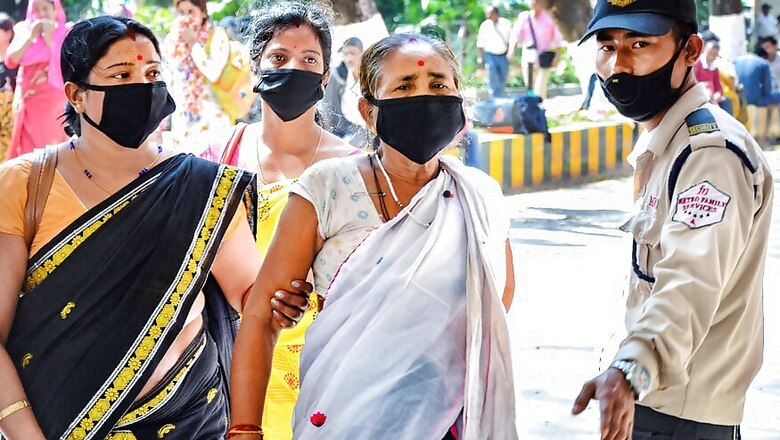
views
New Delhi: Take demographic science into account while adopting measures to mitigate the COVID-19 pandemic, experts are saying to governments and policy makers.
This is because it has been found that deaths caused by the novel coronavirus have been concentrated among the elderly. Since the issue of an ageing population is more pronounced in wealthier countries, “it mercifully may lessen the impact of this pandemic on poorer countries with weaker health systems but younger age structures”.
This has been observed by authors of a study, 'Demographic science aids in understanding the spread and fatality rates of COVID-19'. It highlights the important role of demography, particularly how the age structure of a population may help explain differences in fatality rates across countries and how transmission unfolds.
The authors have examined the role of age structure in deaths in Italy and South Korea and illustrated how the pandemic could unfold in countries with similar population sizes but different age structures, showing a dramatically higher burden of mortality in nations with older versus those with younger populations.
The study pointed out “the rapid spread of COVID-19 has revealed the need to understand how population dynamics interact with pandemics now and in the future".
The powerful interaction of demography and current age-specific mortality for the disease suggests that social distancing and other policies to slow transmission should “consider both the age composition of local and national contexts as well as the social connectedness of older and younger generations”, said the study.
It was conducted by Jennifer Beam Dowd, Valentina Rotondi, Liliana Andriano, David M Brazel, Per Block, Xuejie Ding, Yan Liu, Melinda C Mills, Leverhulme Centre for Demographic Science, University of Oxford & Nuffield College, UK.
For dealing with the pandemic, it would be helpful if the countries provide case and fatality data disaggregated by age and sex, the researchers said.
Elderly more vulnerable
The report pointed out that currently COVID-19 mortality risk is highly concentrated among older people, particularly those aged 80 and above. “In China, case-fatality rate (CFR) estimates range from 0.4% (40-49 years), jumping to 14.8% (80+ years). This is consistent with the data from Italy as of March 13, where the reported CFR is 10.8% for those 70- 79, 17.5% for 80-89, and 21.1% for those >90, with only six deaths under the age of 50. Thus far, only 3% of deaths have occurred in those under aged 60."
Highlighting the importance of age structure, the report said that population age structure may explain the remarkable variation in fatalities across countries and why countries such as Italy are especially vulnerable. “Italy is one of the oldest populations in the world with 23.3% its population over age 65, compared to 12% in China. Italy is also a country characterized by extensive inter-generational contacts which are supported by a high degree of residential proximity between adult children and their parents,” said the report.
It was pointed out that even when inter-generational families do not live together, daily contacts among non-co-resident parent-child pairs are frequent. “Many Italians also often prefer to live close to their extended family and commute to work daily. According to the latest available data by the Italian National Institute of Statistics, this extensive commuting affect over half of the population in the northern regions.”
These inter-generational COVID-19 transmission chains that begin in younger populations may have a low number of severe cases and thus go undetected longer with countries thereby slow to raise the alarm. This also explains that the “low case fatality rate in England thus far (0.01%) may reflect the relatively young age structure of populations impacted to date, including Greater London, which has a small fraction of residents over age 65 compared to more rural areas”, said the study.
COVID-19 was only detected in King County, Washington once it reached the Life Care Centre in Kirkland, where 19 out of 22 deaths occurred, despite estimates based on virus genetic sequences suggesting it circulated for several weeks prior. “Once community transmission is established, countries that have a high level of inter-generational contacts and co- residence may see faster transmission to high-fatality age groups as seen in Italy,” said the study.
Demographic science and COVID-19 policy
To make demographically informed projections will better the predictions of the COVID-19 burden and inform governments about targeted action, according to the experts.
The study said that while population age structure is crucial for understanding the populations at the highest risk of mortality both across and within countries, it is also vital for understanding how much social distancing measures are required in each population to reduce the number of most critical cases and overload on the health system—aka “flattening the curve”.
The illustrations of the experts show that countries with older populations will need to take more aggressive protective measures to stay below the threshold of critical cases that outstrip health system capacity. “For these measures to be effective, special attention should be devoted to those population groups that are more at risk and patterns of intergenerational contact,” said the study.
For instance, schools have shut down as they are considered a hub of contact and virus transmission, and children are brought closer to grandparents, becoming the default carers. “In aged populations with close inter-generational ties, governments need to facilitate childcare solutions that reduce contact. In a pending decree, for instance, the Italian government will introduce a special leave for parents with children at home from school and a voucher (around 600 euros) for babysitting,” said the study.
The age structure of populations also suggests that the often squeezed “sandwich” generation of adults who care for both the old and young are an important link for mitigating transmission.
The study suggested beyond introducing sick pay for those who need to self-isolate or care for family members, joint government and industry emergency policy measures should seek to counter family economic crises by delaying rent and mortgage payments for example, particularly for vulnerable and precarious workers. “In the absence of economic security measures, this crucial sandwich generation may be less able to comply with policies that allow social distancing,” said the report.















Comments
0 comment